When speaking of European wine regions, you might not readily think of the Czech Republic. I do not blame you if you picture the rolling hills of Tuscany or vineyards in Spain instead. Not many of us realize that the rich heritage of Czech wine dates back to the 3rd century. Considering that today you can enjoy this through interesting wine trails and experiences, it’s time to shine the spotlight on wine tourism in the Czech Republic.
On a recent trip to the Slovácko wine region of South Moravia in the Czech Republic, I had the pleasure of visiting historic wineries and chateaus, touring medieval-era wine cellars, harvesting grapes in lush vineyards, learning from Czech winemakers how to press grapes the traditional way, experiencing the wine culture, and wandering through quaint wine villages.
We drove through stunning landscapes typical of wine regions—the kind that I’d never imagined I’d see in the Czech Republic. This part of the country, easily accessible from the cool, youthful city of Brno, is known as Moravian Tuscany, and should be on your radar, for the fantastic wine, dreamy views, and rich cultural experiences, especially if you’re a wine lover. It can also be explored by a well-maintained network of bike trails.
I had the pleasure of tasting some of the finest wines in South Moravia and came away with a real appreciation for South Moravian wines, many of which are award-winning.
So whether you’re looking for wine-tasting tours in the Czech Republic or to experience the country’s wine tourism over a few days, I hope this post fuels your imagination and provides some pointers on what to expect on a wine trip to the Czech Republic.
If you’re interested in the wine scene in the Czech Republic beyond wine tasting in cities like Prague, it’s a good idea to either do so by day trips from Prague or Brno, or alternatively spend a part of your itinerary, so at least a few days, in the wine region of South Moravia.
This 7-hour wine tasting and villages tour is an example of what to expect on a wine-themed day trip from Prague if you go with a local operator.
But if you’d rather do this on your own, you can use the suggestions in this post to plan your own itinerary focused on wine tourism in the Czech Republic, after spending some time exploring the city of Brno.
Additionally, the official website offers information on wine trails (including bike trails) and wine-related events and wine harvest festivals.
Wine Regions of the Czech Republic
There are two wine regions in the Czech Republic—Bohemia and Moravia, and about 17,531 hectares of vineyards in the country. South Moravia is home to nearly 96% of the country’s vineyards and produces numerous varieties of wine including Pinot Gris, Pinot Blanc, Pinot Noir, Sauvignon Blanc, Cabernet Sauvignon, Chardonnay, Riesling, and more.
The first mentions of wine production date to Roman times in the 3rd century but it was in the 11th century that viticulture began to be documented more extensively. The modern-day success of Czech wines and the wine industry was set into motion by the move to modernization in the 1990s.
I had the opportunity to experience the best wines of South Moravia which is further divided into the sub-regions of Znojmo, Mikulov, Velké Pavlovice, and Slovácko (where my trip was based).

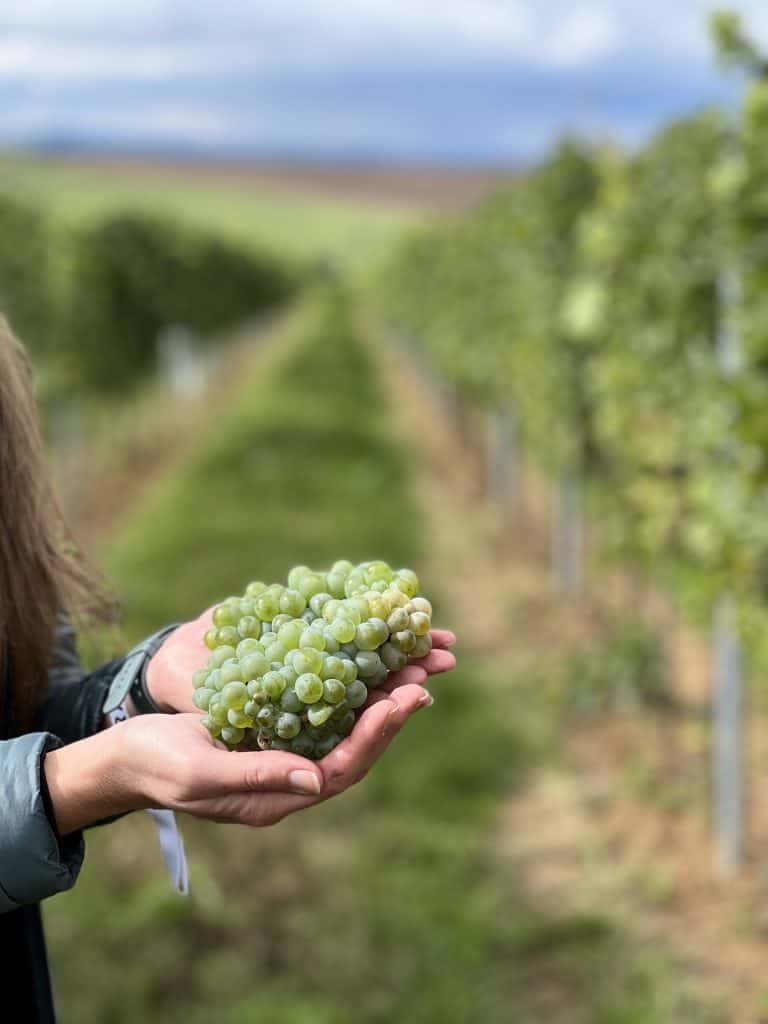
Are Czech wines even that good?
During my first trip to the Czech Republic, I fell in love with Czech beer, and I’d heard so much about it. Maybe you have too, so you might be wondering if Czech wines are even that good. To answer that in one word: Yes.
Thanks to fertile soil and a suitable climate, Czech white wines are exceptionally good, and comparable in quality to those from other well-known wine regions in countries like Italy and France.
Rosé wines have become popular in recent times, and there are also some great red wines being produced in the country.

The Czech wine industry is also known to produce some quality ice wines made using pressed frozen grapes, and straw wines made by using straw to dry matured grapes.
South Moravian wines are considered a national treasure, with several having won awards and gold and silver medals internationally.
Can you go on wine tasting or wine tours in the Czech Republic?
Whether you’re looking to get the Czech wine experience over a day or a week, there are many options available in the form of wine-tasting tours, winery visits, wine trails, grape harvests, and festivals.
You can even book accommodation in a winery surrounded by vineyards and get a longer, more immersive experience while you taste wines of excellent quality.

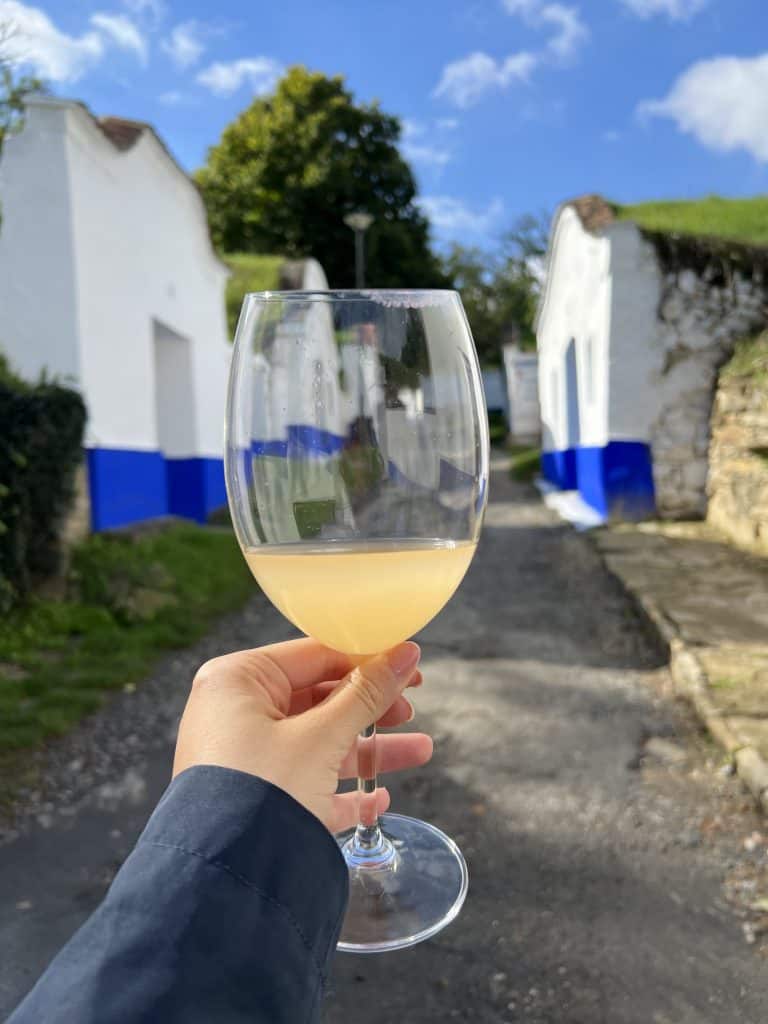
If you visit in autumn, you can participate in grape harvest and make Burčák, something I had the chance to do and absolutely loved.
Things to Do on a Czech Wine Tour in South Moravia
Tour a beautiful 18th-century chateau
Our wine journey in South Moravia began at the Slavkov Chateau, a castle that was built in the early 18th century, surrounded by vast Baroque gardens on the estate in Slavkov u Brna.

Once the seat of the Order of German Knights, the castle (or chateau) was built as the residence of the influential noble Kaunitz family in 1769 after the estate was acquired by Ulrich von Kaunitz in 1509.
Napoleon is known to have stayed in the chateau after the French victory in the famous Battle of Austerlitz that took place on December 2, 1805 between France and the allied army of Austria-Hungary and Russia.
Thanks to its significance in key historical events in the area, it was declared a national cultural monument in 2008 and is owned by the town of Slavkov u Brna.
Not long after we’d set foot into the stately castle, having been welcomed with glasses of wine and wide smiles by the couple, long-haired Prince Ernst Christoph Kaunitz-Rietberg, told our group that his wife Maria Leopoldine von Oettingen-Spielberg, who looked on dressed in a peach gown, was extraordinarily good at spending the family riches. She replied with a coy smile, “Not the money you wouldn’t have.” A perfectly-matching peach-colored pouch dangled from her finger for effect.

This witty back and forth between the actors, Mrs. Radka and Mr. Kučera, who pretended to be the aristocratic owners of the estate set the tone of our costumed tour of the Slavkov Chateau, easily turning it into one of the most fun experiences on our trip around South Moravia.
We were shown around the castle halls and various rooms filled with portraits, paintings, sculptures, antiques, and all manner of riches while listening to stories—some hilarious, others intriguing, and some that kept us guessing.
Walking through the Hall of the Ancestors, Historical Hall, and a chapel, and admiring the frescoes on the ceilings felt like wandering through history—the days of aristocrats, grandeur, and wars.
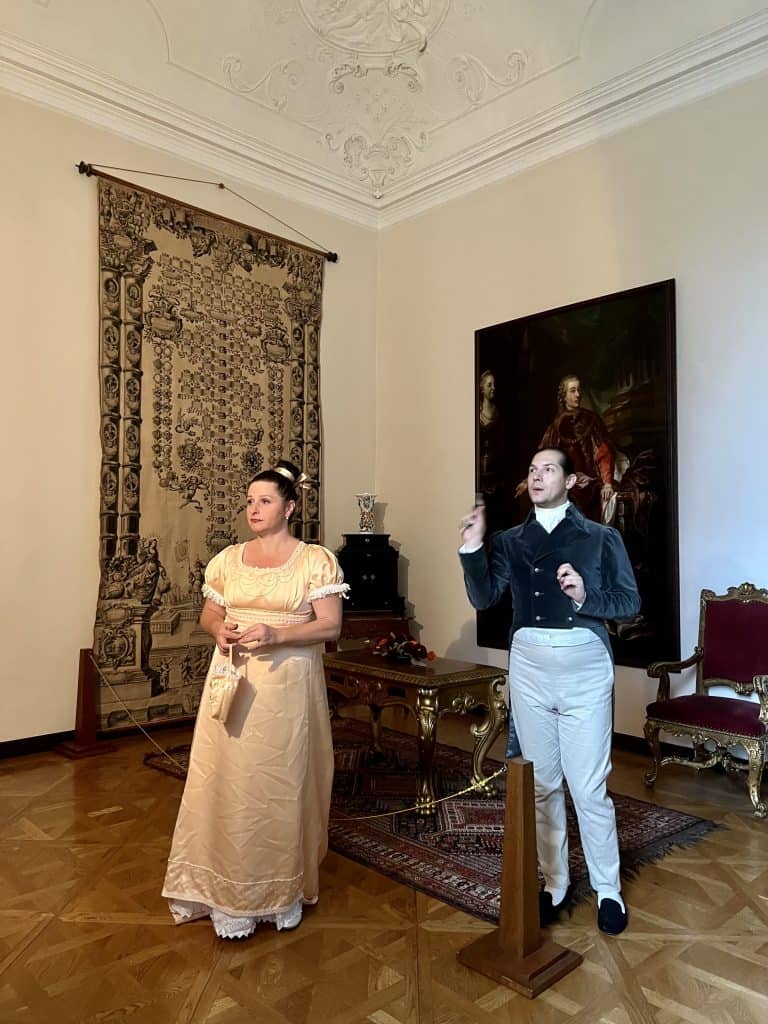



Afterwards, we sat down to enjoy open sandwiches, baked goods, sweet treats, and coffee with pleasing views of the surrounding gardens.
If you’re not pressed for time, a game of golf can be enjoyed at the 6-hole golf course of the Austerlitz Golf Resort which is connected to the estate gardens.

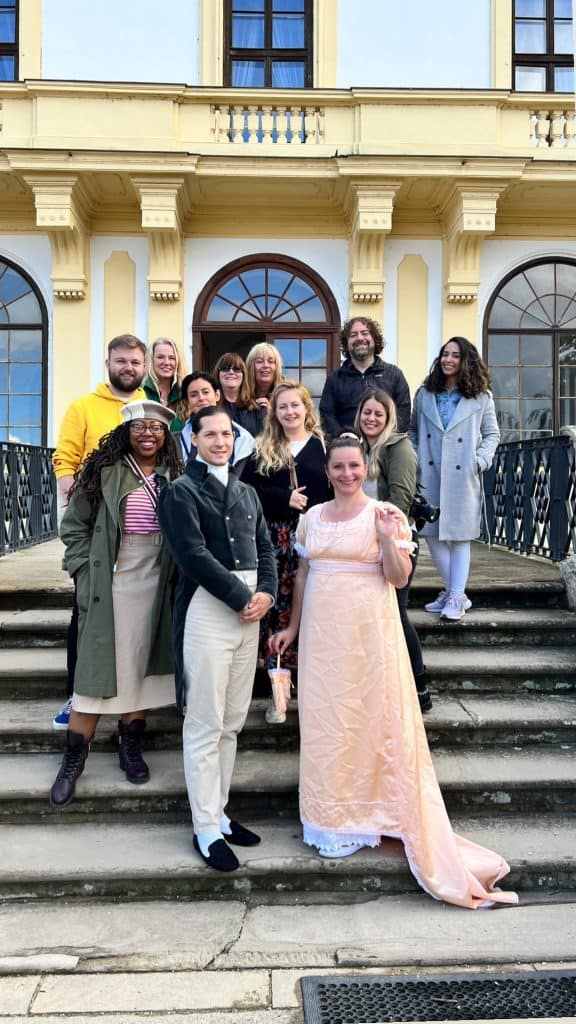
See Moravian Tuscany and Sample Wines at Vinařství Spielberg
Under bright blue skies where the sun played hide-and-seek through the clouds, we set forth on our journey of tasting Czech wines with a visit to Spielberg Winery.
On the terrace of the winery, I gently swirled my glass of sparkling Crémant de SPIELBERG and rested my eyes on the beautiful surroundings. The village of Archlebov with red-roofed houses encircled by a countryside lush with undulating hills and meadows, and vineyards in the distance.

The earliest mention of grape harvest in the vineyards owned by this 20-year-old winery dates to the 13th century—just goes to show what a long history of wine production this region has.
The wines produced at Spielberg Winery have won numerous awards, and the winery is among the 8 best wineries in the Czech Republic, the seventh time in a row. The high-quality wines produced here are a result of their meticulous attention to ecologically sound practices and drawing from the best of both traditional and new techniques.
Grape varieties such as Rhine Riesling, Pinot Gris, Pinot Blanc, Meunier, Chardonnay, Müller-Thurgau, Pinot Blanc, Moravian Muscat, and Pinot Noir are grown in the Spielberg vineyards, which are spread over 65 hectares across Moravian Tuscany.
An illuminated map of these vineyards is exhibited in the Tasting Room (and shop) at Spielberg Winery, and offers more context and stories about the area. It was in this cozy and modern space that we tasted one of my favorite wines of the entire trip—a balanced, fruity white cuvée (wine that is a blend of a few different grape varieties) called Petit Chat.


If you’re a small group or a couple booking a wine tasting, you’ll probably enjoy it here, alongside a deli-style spread of local cheeses, sausages, pate, and pastries.
Later, over a delicious lunch in the elegant Crystal Hall—perfect for weddings— I quite enjoyed another cuvée called Moravské Toskánsko, also a white wine.


A tour of the cellars and wine production facilities, with more tasting of course, summed up our visit to Spielberg Winery.
On our way to our next destination (and me already with my first wine purchase of the trip), we stopped at their vineyards in Moravian Tuscany, clinking glasses in what was a sublime landscape of vineyards under dramatic cloudy skies.
If you’re interested in booking a wine tasting at Spielberg Winery, you can find more information and do that here.
See Medieval Life in an Open-Air Museum
A visit to the Strážnice Museum of the Villages of South-East Moravia is a fun and engaging way to learn about the folklore, traditions, and way of life in medieval times in the wine-producing villages of South Moravia.
Combining influences from the areas of Moravian Kopanice, Luhačovice Zálesí, and Horňácka in the Slovácko region, the open-air museum is built to resemble these villages, complete with houses in the traditional architectural styles, working farmsteads, vineyards, and winemaking equipment, themed exhibitions, and even a smithery that you can visit.




On our guided tour (something I highly recommend here), we got to learn about traditions like gamekeeping, weaving, plum butter making, sauerkraut pressing and fermentation, bread baking, and gingerbread decoration.
Not only did we see them in action by guides dressed in traditional clothing, many of who grew up doing them, we even participated in a few activities. This experience was far more enjoyable than reading blocks of text on information boards (as you’d normally do in a museum)—and something I imagine is fun for adults and kids alike. The museum shop is an excellent place to buy some authentic, handmade souvenirs.
It might be worth seeing if you can time your visit to the museum to coincide with an event or festival when you can expect parades and even more activities.
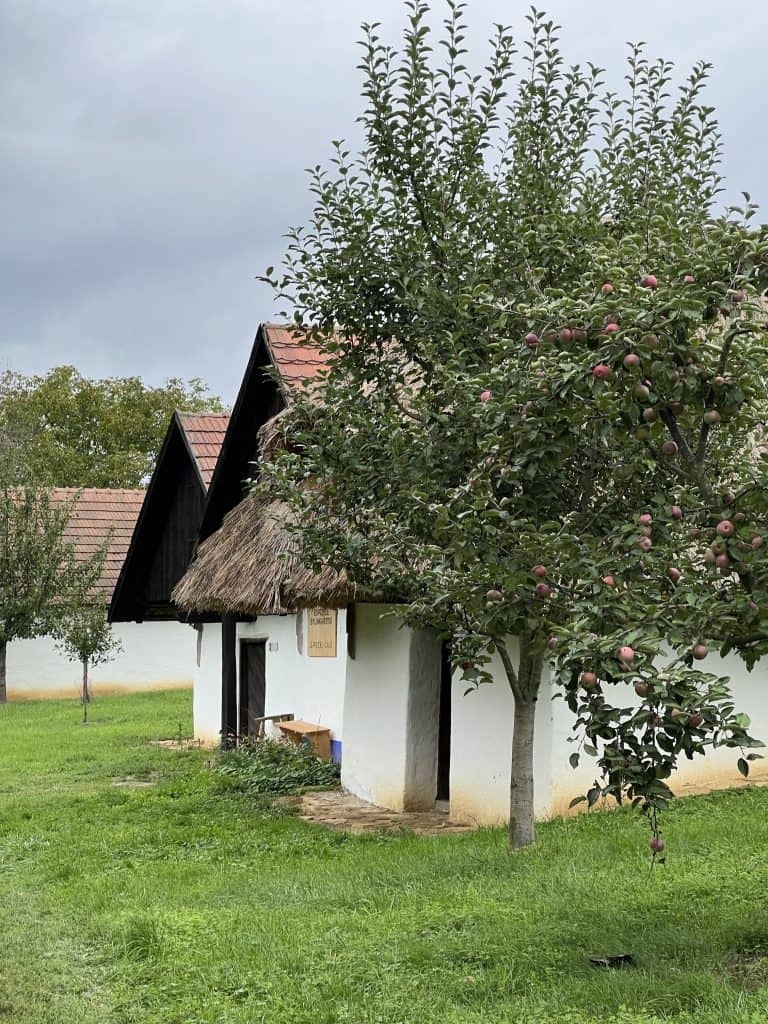




Go Wine Tasting in a Castle at Chateau Bzenec Winery
When we began to approach a Gothic castle complex in the town of Bzenec for our next wine tasting, I knew this was going to be a special experience. The multiple award-winning Zámecké Vinarství Bzenec (or the Chateau Bzenec Winery), while modern in its sensibilities, is backed by a rich history and a strong foundation in the art of winemaking.

The winery manages about 540 hectares of vineyards in the sub-regions of Slovácko, Mikulov, and Znojmo, and produces a variety of wines such as Chardonnay, Grüner Veltliner, Moravian Muscat, Sauvignon Blanc, Pinot Blanc, Rhine Riesling, and Wallachian Riesling. An eight-time winner of the Wine Salon of the Czech Republic, an annual wine competition that recognizes the best wines in the country, this winery produces quite a few award-winning wines.
After a tour of the wine production area, we made our way to the wine cellars underneath the castle, where the quietness of corridors and halls, named after royals and nobility, was bursting with storied histories from times long past.
Here in the Rotunda of Adolf Heyduk, we had the honor of tasting the Sekt 1876 2017, the first-ever sparkling wine in Bohemia and Moravia, in the very place where it was first produced in 1876—what a historic setting! The rotunda is named after a Czech writer who loved the wine.


In one of the cellar halls stood large hand-carved oak barrels from the early 1990s, adorned with folklore scenes from the wine sub-regions where the winery grows its grapes.
As we passed by old black and white photographs, Rastislav Janovíček, our host and Marketing Officer at the winery, pointed to a photo of a chapel overlooking vineyards and told us that it was somewhere we absolutely should go and that a set of stairs led up to it from the town, “I’ll say it’s the Stairway to Heaven,” he added with a smile. Naturally, our curiosity was piqued and we made plans to visit the Chapel of St. Florian and Šebestián the following day.
For the next part of our evening, i.e. tasting the best, award-winning wines at Zámecké Vinařství Bzenec, we headed into the Tasting Room of the winery. Reminiscent of medieval dining rooms, our table looked like it had once hosted kings and queens. Here alongside a lavish dinner spread, we tasted nine different wines including the Rulandské bílé from the award-winning Klínky vineyard and a couple from the winery’s Ego series.
Enjoy the Views at the Chapel of St. Florian and Šebestián
The Chapel of St. Florian and Šebestián was our first stop the next day, thanks to Janovíček’s exciting description of the location. That had not been an exaggeration—the chapel overlooked vineyards on the surrounding slopes and the town of Bzenec below. It was a romantic spot, kind of perfect to enjoy a glass or two of wine over a sunset picnic.


The Baroque chapel was first built in 1703 on the ruins of an old castle, surrounded by newly planted vineyards on the hillsides below.
But over the years, misfortune befell upon the chapel several times, in the form of being struck by lightning, which set fire to the roof and tower, a few times. It was repaired each time, most recently in 2017 after it was blown up by Nazi troops in 1945. The slopes were replanted in 2016 by the Chateau Bzenec Winery in an attempt to restore them to their former health.
If you plan to visit, you can do the 20-minute walk from the town of Bzenec, or rent a bike to get here. You can also drive up to the chapel.


Experience Grape Harvest and Wine Tasting at Skalák Winery
While I’ve certainly been on many wine-tasting tours around Europe, my visit to the award-winning Skalák Winery was truly unforgettable. I actually got to experience a day in the life of a winemaker, right from harvesting grapes in their vineyard (a first for me) and pressing the grapes using a traditional wine press, to making our own cuvée (blend of wines).
Our morning began with a visit to their vineyard where after a quick demonstration, our group split into pairs and got to work collecting the grapes in large crates.


Snipping the grapes off the vines under blue skies, breathing in the fresh air, and being surrounded by such a pretty landscape—this was an experience that was exciting and therapeutic at the same time. It also led to a more tangible realization of what lies at the beginning of the journey of a bottle of wine.
Then, we made our way back to the winery, where the grapes were separated from the stems and leaves in the mill before being loaded into a traditional wine press. At this stage, we tasted the fresh grape juice, or must as it’s known in the winemaking world—sweet and delicious.


We took turns working the press, which requires you to use a good deal of strength, and is certainly not easy as it looks, by the way. These days, the process is automated and is as simple as pressing a button for the machines to do all the work. We were each given a bottle of grape juice that would soon become burčák or young wine after a 48-hour fermentation process.

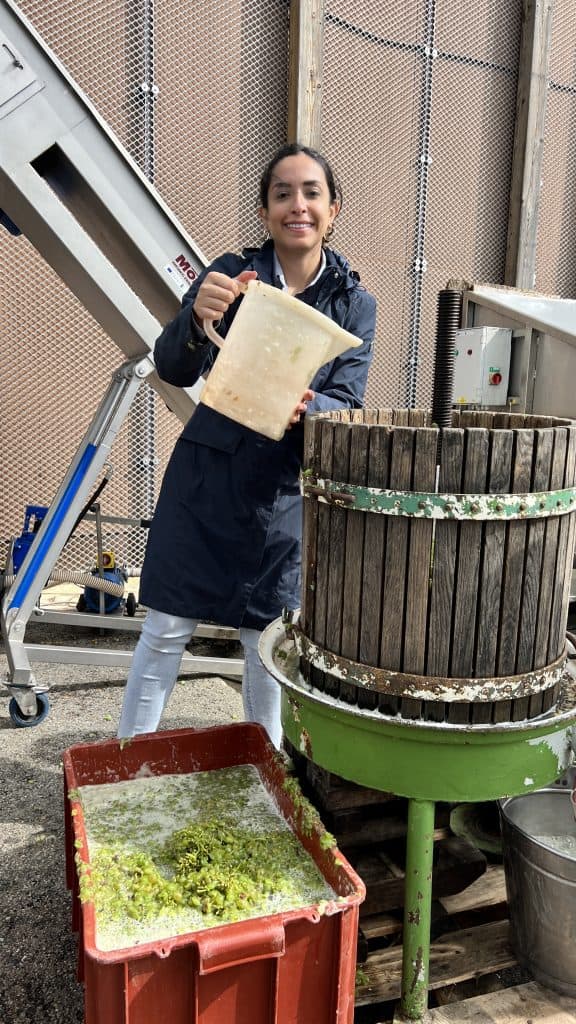


After that hard work, we made our way to the hunting lounge of the family-run winery for lunch paired with some of their best wines. Skalak Winery places a lot of significance on the influence of terroir on their wines, something they define as the collective natural conditions of the place their vines are cultivated which creates unique wines with unrepeatable character and origin.
They produce several award-winning wines that have won accolades internationally such as the semi-sweet Pálava Nadskalí 2021 and the fruity dry Sauvignon late harvest 2020, among many others. Skalak Winery was the Golden League 2022 Winner, a prestigious wine competition that involves four events held in various locations around the world.

But our lesson in all things wine wasn’t done yet. We were then led into the Tasting Room, split into teams, and asked to create our own cuvées using three of their wines. Each team’s wine blends would be judged by the sommeliers, with a prize for the winning team.

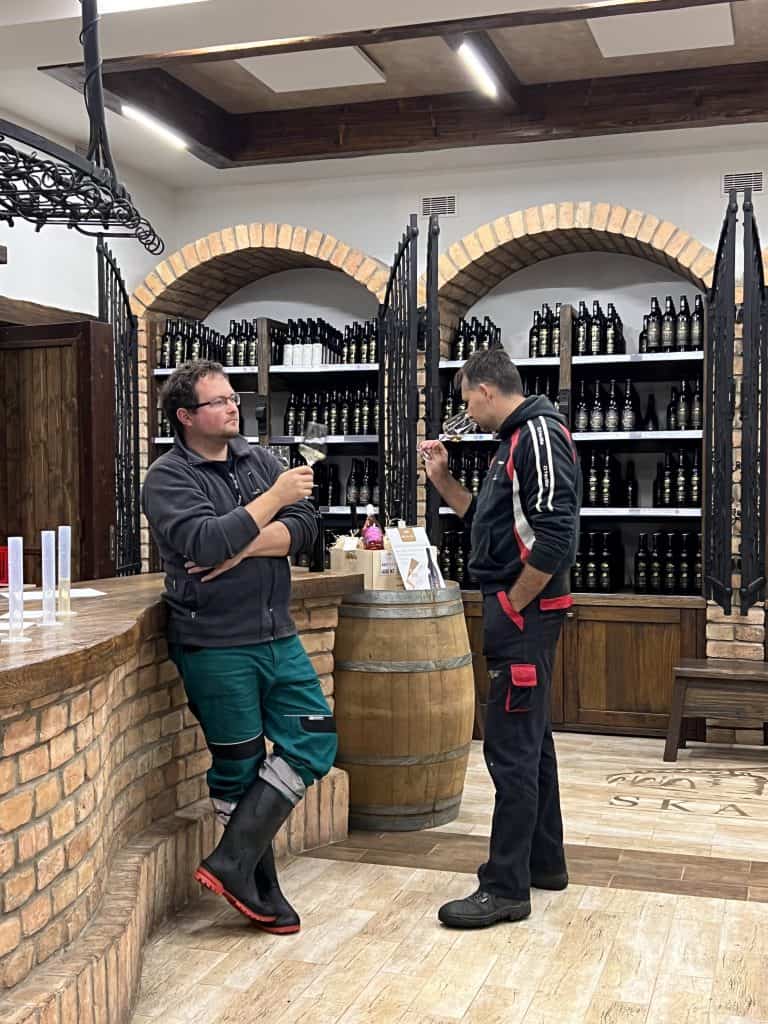
There was a lot of tasting and animated discussions about notes, balance, aftertastes, and acidity, after which we were ready. We watched nervously as the two sommeliers swirled their glasses, smelled the cuvées, and solemnly discussed each wine in detail. My team did not win, but it was such a fun and educational experience, I’d love to do it again sometime.
Ride a Pedal-Powered Train
In Ratíškovice, where our next adventure awaited, I reached for a plum jam-smeared potato pancake called Bramborové patenty, because I am the kind of person who cannot resist a plate of beautifully arranged snacks.

Little did I know that it isn’t possible to have just one of these pancakes—oh, the joy of sweet and savory at once, and the flavor of poppy seeds kept me going for more. These pancakes by Linda Horká, a recipe passed down through the generations, were the perfect fuel for our next activity—riding a pedal-powered train on an old railway track.
The track was once used to transport coal from mines onward to the Bata canal for industrial activities. Today you can rent a pedal-powered wagon (200 CZK/hour at the time of writing) that seats six, with two people pedaling on the bikes that fit into either end of the wagon to power it forward on the track.


At 3km, the track isn’t too long and goes through a beautiful forest outside of town. It takes about an hour to return to the start of the journey, which doesn’t feel too bad if you don’t mind pedaling for that long.
Take a Boat Ride on the Bata Canal
A relaxing boat ride on the Bata Canal, a 53 km waterway between the towns of Kroměříž and Hodonín, is a great way to experience the natural beauty of the Slovácko region on a laidback morning or afternoon. We traveled from Straznice to Petrov, a 45-minute journey filled with sublime views and the sounds of chirping birds.



Built in the 1930s with 13 locks to ease the transport of coal from the mines at Ratíškovic to the Otrokovice power station that powered the Bata factories (you might be familiar with the company Bata Shoes), today the canal is used mainly for recreation.
We cruised on the canal through the verdant landscape, soaking in its quiet beauty, and watched joggers and cyclists pass by on the trail that runs alongside the canal.
There are various ports along the canal with boats and canoes available to hire as well as bikes to rent. You can also plan for a longer stay in a houseboat and spend your days fishing and visiting chateaus, wine cellars, and a protected bird reserve in the surrounding villages.
Visit the Plže Wine Cellars in Petrov
Straight out of a Czech folk tale, the Plže Wine Cellars in Petrov date back to the 15th century and were originally built by wine-producing families for their use. Today, these 80 wine cellars—each in a white and blue house with colorful floral designs painted above doors and windows—are a protected folk architecture site. Traditional wine presses and statues outside some houses are a nod to the long heritage of viticulture in the area.
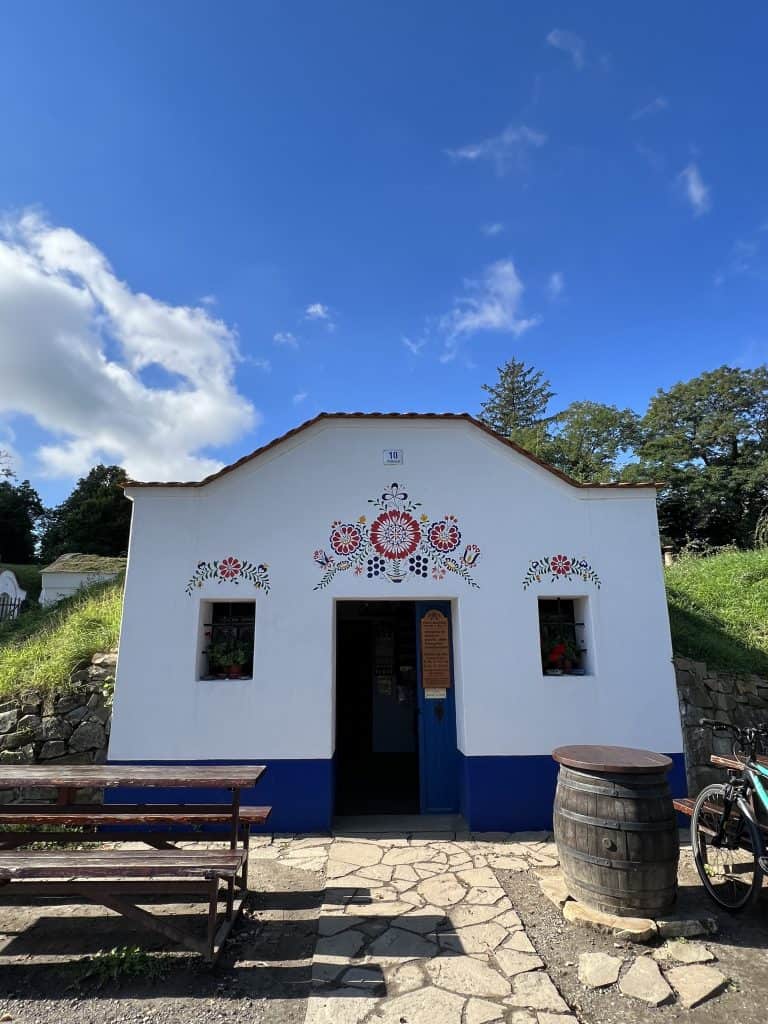


Inside a few, you’ll find casual wine bars serving their own wines, so you can stop for a refreshing glass of wine or Burčak (young wine). There are also shops selling beautiful locally handcrafted souvenirs, the kind of stuff you’d find in your grandma’s house if she were Czech.
The houses are next to each other, so it’s easy to walk around them. The area really comes alive in summer and during festivals and events.
Explore the Moravian Wine Routes
The Moravian Wine Routes are a 1,200km-strong network of marked bike trails that take you along verdant countryside and forest trails past vineyards, meadows, gardens, and wine-producing villages with historic chateaus and wine cellars. There are different trails available for varying abilities, from beginner-level to more advanced routes, and you can also choose according to what kind of wine you like best.

Where to Stay on a Wine Trip in South Moravia
Hotel Lidový Dům Bzenec
In the town of Bzenec, within 10 minutes walking distance of Chateau Bzenec Winery, Hotel Lidový Dům Bzenec offers simple but comfortable rooms with free WiFi and en-suite bathrooms. Some room windows face the street but it’s not too loud when you’re trying to sleep. There are larger apartments available.
The modern restaurant and bar has an outdoor terrace and is a good place for a meal. It also serves breakfast (included in the room price).
Hotel Kyjovský pivovar
Kyjovský pivovar is a brewery and hotel, and while you might think that a brewery hotel might be an unusual choice for a wine-themed trip, I’m going to ask, “Have you ever experienced a hops/beer spa?” Do you see where I’m going with this?

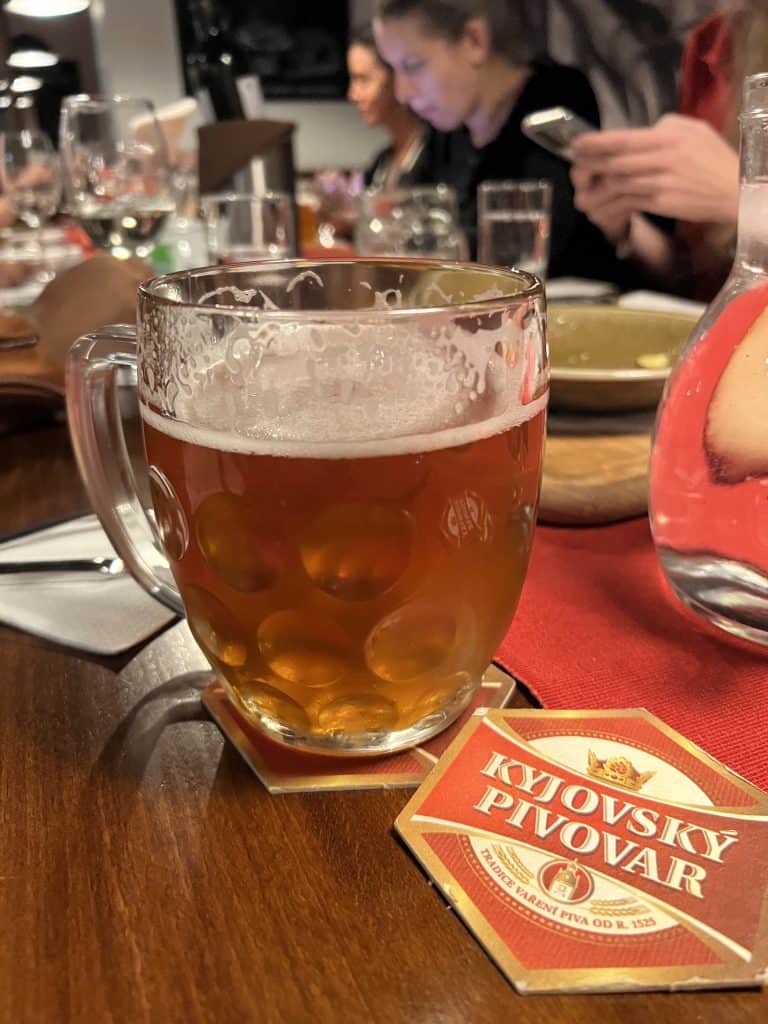
The rooms are pretty basic but comfortable and come with free WiFi and private bathrooms. There’s a spa where you can book a hops spa for two, it cost me 100 CZK and it was such a relaxing and unique experience, totally worth it.
Downstairs is a beer-hall-style restaurant that serves delicious food and a variety of homemade brews. Breakfast is included. There’s an outdoor pool as well.
Accommodation Blue Hydrangea (Spielberg Winery)
Many wineries in South Moravia also offer accommodation for guests who want to truly immerse themselves in the landscapes and culture of the wine regions. Spielberg Winery offers ten tastefully-designed air-conditioned apartments in the village of Archlebov. These are spacious and come with fully-equipped kitchens, living rooms, bedrooms, private bathrooms and a terrace. They’ve got options for breakfast too, whether made-to-order or buffet.
Accommodation at Skalák Winery
Skalák Winery also offers simple air-conditioned rooms and apartments with private bathrooms, as well as attic rooms with shared bathrooms. Rooms come with free WiFi, and breakfast is included.
Food, Beer and Wine tours in Czech Republic
Also visiting Prague on your trip to the Czech Republic?
Book your trip to Prague
Check rates and availability for hotels in Prague
Get the official Prague Visitor Pass for unlimited travel by public transportation and entry to museums, attractions, sights and more.
Save money on your Prague trip with the Prague CoolPass which includes a sightseeing bus tour and two river cruises plus entry to over 70 Prague attractions (such as Prague Castle and the Jewish Museum) and special offers on tours, entertainment, food, and shopping
Get an e-sim for your trip to Prague (that I use and love)
Get Unlimited 4G Internet with Pocket EU Wi-Fi for your trip
Book a private airport transfer in Prague
Book the hop on hop off bus with river cruise in Prague
Check flights to Prague
I visited South Moravia as a guest of Visit Czech Republic, South Moravia, and Slovácko sub-region. All opinions, as always, are honest and independent.

